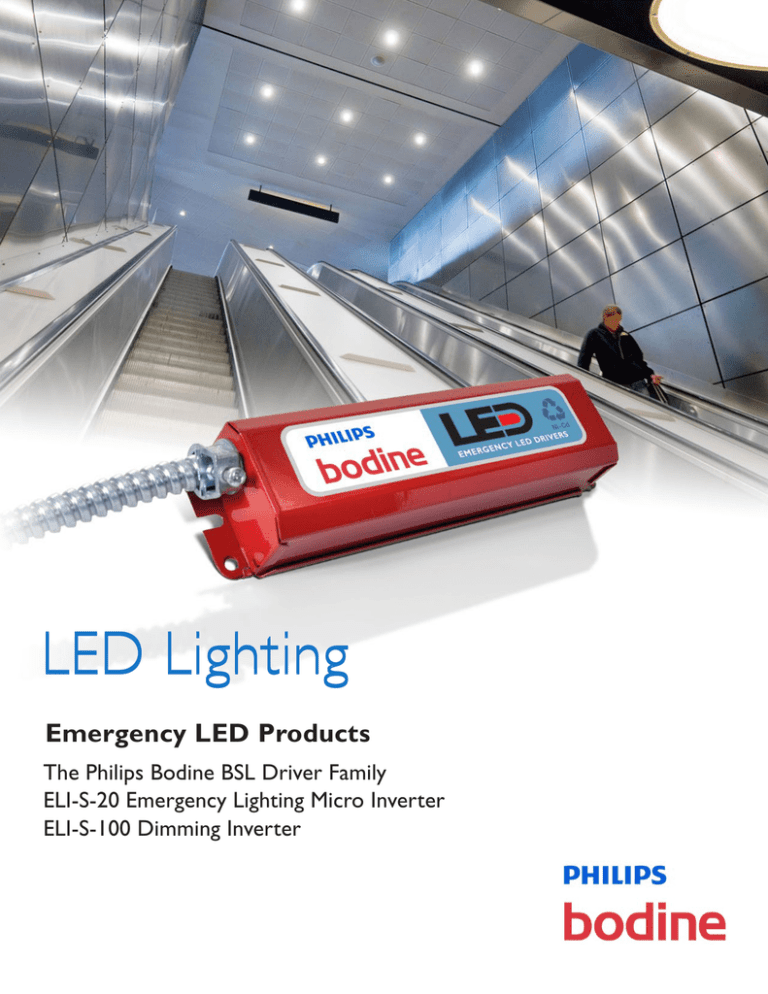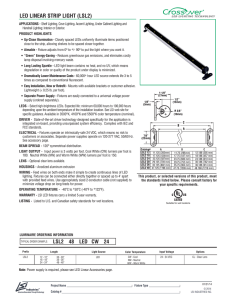
LED Lighting
Emergency LED Products
The Philips Bodine BSL Driver Family
ELI-S-20 Emergency Lighting Micro Inverter
ELI-S-100 Dimming Inverter
Philips Bodine emergency LED drivers answer the call for
LED Technology
From torch lighting to
porch lighting, T12 to
T5 HO, filament to LED,
technology evolves.
So do we.
LED technology is a new frontier. For most in the lighting
industry there is a very real learning curve as we explore the
intricacies, applications, limitations and potential of this amazing light source. Despite the curve, use of LED lighting for
general lighting purposes is growing. As with other types of
lighting, LED lighting must meet the life safety code requirements for emergency illumination. LED fixtures serving as
emergency units must, therefore, provide at least 90 minutes
of emergency lighting. Philips Bodine emergency LED drivers
and emergency lighting inver ters allow these fixtures to meet
or exceed code.
As with other types of lighting, LED lighting must meet the life
safety code requirements for emergency illumination.
2
LED brochure
emergency lighting in LED applications.
Terminology
Array: A configuration of one
or more (usually many more)
LEDs connected to the same
power source.
Emergency LED Driver: A device
that uses electronic circuitry to convert
energy stored in a battery into the DC voltage and current necessary to drive the LED load within the
parameters established by life safety
codes.
Integral-Base Lamp:
A lamp in which the driver
is built into the base. Because
the lamp driver is built into the
base, an emergency LED driver
cannot be wired in between it
and the lamp/LED/LED array. A unit
with an integral base must, therefore, be
driven in emergency mode by an inverter
product, such as the Philips Bodine ELIS-20 Emergency Lighting Micro Inverter.
LEDs in Parallel: In parallel devices, all
of the (+) terminals are connected and
all of the (-) terminals are connected.
All devices have the same voltage across
them and draw as much current as
their internal resistance allows. If all the
devices are exactly the same, the current
through each will be equal and the total
current draw from the power supply will
be that individual current multiplied by
the number of devices or parallel legs
connected. When LEDs are wired in parallel, each LED or group of LEDs will have
the same voltage demand from the driver
and draw an equal amount of current.
LEDs in a Series: The (+) terminal of one
LED is connected to the (-) terminal of the
next. When LEDs are wired in series, the
voltage necessary to run them is the sum
of the individual LED voltage drop and the
current is the same in all LEDs.
LED: Light-emitting diode. A semiconductor device (diode) that emits visible light when electricity is applied.
LED Driver: A device that converts line
voltage into the DC voltage and
current necessary to drive
the LED load.
Light Engine: A configuration of LEDs,
often series and parallel, that cannot
be divided by changing the wiring
between the LEDs. Thus, a power
source drives the whole unit or
nothing at all.
LED brochure
3
Choosing the Best Emergency LED Driver
Selecting Emergency Drivers:
OEM Solutions for Factory Installation
Although we recommend that you send us your fixture or request a sample driver from
us to test in your fixture, there are two critical pieces of information that will help you
select the best emergency LED driver for your project.
The leader in
emergency lighting
technology delivers
LED Array Voltage.
Wiring Specifics.
What’s the LED array voltage you’re using? For best
results, this voltage should be in the midrange of the
output voltage for our products. For example, the
Philips Bodine BSL23C has an output range of 3.0
to 20 VDC. If your LED array voltage is around 12.0
VDC, BSL23C could be a good option. If your array
voltage is 18 VDC, however, the match would be less
ideal, though it still may work.
How are the LEDs wired? Are the LEDs in a series
or parallel? Is the wiring accessible? When LEDs are
wired in series, the voltage necessary to run them
is the sum of the individual LED voltage drop and
the current is the same in all LEDs. If they’re wired
in parallel, each LED or group of LEDs will have the
same voltage demand from the driver and each will
draw an equal amount of current. Thus, the summed
currents in the parallel configuration may quickly
exceed our capability or result in dramatically lower
lumen output than expected. In terms of wiring
accessibility, wiring that is accessible gives you the
option of connecting as few or as many LEDs as appropriate to the emergency driver.
again with emergency
LED drivers.
4
LED brochure
Philips Emergency Lighting offers
emergency drivers for LED lighting
applications. These drivers permit LED
fixtures to serve as code-compliant
emergency lighting units.
NON-REGULATED
REGULATED *
Philips Emergency Lighting Driver Portfolio
Model
Output
Voltage
(VDC)
Typical
Output
Current
(mA)
Typical
Output
Power
Dimensions
Features or Applications
BSL17C (conduit)
BSL17 (non-conduit)
45 - 130
100 - 200
7.0 W
12” x 2.4” x 1.5”
Multiple mounting configurations;
Ideal for LED downlight applications;
Universal input
UL Component Recognized
for factory installation only;
CSA Certified
BSL17C-C2* * (conduit)
BSL17-C2* * (non-conduit)
15 - 50
100 - 270
7.0 W
12” x 2.4” x 1.5”
Class 2; Multiple mounting configurations; Ideal for use with Fortimo DLM
and SLM modules; Universal input
UL Component Recognized
for factory installation only;
CSA Certified
BSL10 Cold-Pak
24 - 52
200 - 400
10.0 W
8.97” x 3.5” x 2.9”
+ battery
Easier to install; Output Class 2
Compliant; Cold temperature
(-4 F to +131 F); Universal input
UL Component Recognized
for factory installation only;
Output Class 2 Compliant
20 - 50
50 - 130
125 - 200
400 - 1000
150 - 400
100 - 160
20.0 W
16.6” x 2.8” x 2.85”
+ battery
High output provides 20W constant
output power; BSL20LV is class 2;
Universal input
UL Component Recognized
for factory installation only
BSL722 (non-conduit)
28 - 33
700
23.1 W
9.4” x 2.2” x 1.05”
+ battery
Drives two LED arrays in parallel;
Universal input
UL Component Recognized
for factory installation only;
CSA Certified
BSL722 Cold (non-conduit)
28 - 33
700
23.1 W
9.4” x 2.2” x 1.05”
+ battery
Designed for but not restricted to
cold temperatures (-4 F to +140 F);
Drives two LED arrays in parallel;
Universal input
UL Component Recognized
for factory installation only;
CSA Certified
BSL23C (conduit)
BSL23 (non-conduit)
3 - 20
225 - 410
4.5 W
9.4” x 2.4” x 1.5”
Multiple mounting configurations;
Ideal for downlight and steplight
applications
UL Component Recognized
for factory installation only
BSL26C (conduit)
BSL26 (non-conduit)
3 - 30
120 - 265
5.1 W
9.4” x 2.4” x 1.5”
Multiple mounting configurations;
Ideal for downlight applications;
LVLE compliant
UL Component Recognized
for factory installation only;
CSA Certified
Designed for linear strip fixtures;
Class 2; Metal and polycarbonate
case options available; Universal
input
UL Component Recognized
for U.S.
BSL20LV
BSL20MV
BSL20HV
Listing
BSL310C (metal case with conduit)
BSL310M (metal case no conduit)
BSL310* * * (polycarbonate case no conduit)
10 - 50
200 - 400
10.0 W
BSL310C / BSL310M
15.34” x 2.25” x 1.16”
BSL310
14.5” x 2.25” x 1.18”
BSL310DF (metal case with conduit)
BSL310CP (metal case with conduit)
10 - 50
200 - 400
10.0 W
15.34” x 2.25” x 1.16”
Designed for linear strip fixtures;
Class 2; BSL310DF has dual flex conduit; BSL310CP is compatible with
Cree LMH Modules; Universal input
UL Component Recognized
for U.S.
BSL310C-CAN (metal case with conduit)
BSL310M-CAN (metal case no conduit)
BSL310-CAN (polycarbonate case no conduit)
10 - 36
300 - 400
10.0 W
BSL310C / BSL310M
15.34” x 2.25” x 1.16”
BSL310
14.5” x 2.25” x 1.18”
Designed for linear strip fixtures;
Class 2; Metal and polycarbonate
case options available; Universal input
Suitable for factory installation in Canada and U.S.;
cUL Component Recognized
*Regulated power output over 90 minutes.
** The BSL17C-C2 and BSL17-C2 are UL Classified for use with specific Philips Fortimo DLM (downlight module) and SLM (spotlight module) products. The designation of UL Classified for use with
specific Fortimo DLMs and SLMs means that the BSL17C-C2/BSL17-C2 may be factory installed without additional UL testing in Fortimo fixtures for which an emergency option has been filed.
***The BSL310 is field installable exclusively with the Philips EvoKit LED retrofit. It cannot be field installed without the EvoKit. For more information, please contact PEL Sales at 800.223.5728 or
Tech Support at 888.263.4638.
Philips Bodine BSL products provide 90 minutes of emergency illumination in compliance with emergency codes. See the Life Safety Code® 7.9.2.1 (2012).
All BSL products above are UL Component Recognized for factory installation only.
The lone exception is the BSL310 paired with the EvoKit.
LED brochure
5
UL Listed for Factory or Field Installation.
ELI-S-20
Emergency Lighting Micro Inverter
The Philips Bodine 25W ELI-S-20 emergency lighting micro inverter transforms
LED and fluorescent fixtures into code-compliant emergency lighting.
It is the ideal emergency backup for the
Edison-base (screw-base) LED lamps that
are commonly replacing CFLs in retrofit
applications and is a superior choice for office,
retail, hospitality and other similar spaces.
ELI-S-20 allows fixtures to be on, off,
switched or dimmed. It supports 100% of
AC rated output throughout its 90-minute
runtime so fixtures operate at full brightness
during emergency operation. The device
provides power to the input side of the
fixture, including the ballast, and is designed
for use with indoor applications.
The ELI-S-20 features an LED-friendly
sinusoidal (sine) waveform rather than square
waveform output. Sinusoidal waveform
is characterized by very low harmonic
distortion and by clean power similar to that
produced by utility-supplied electricity, making
the ELI-S-20 well suited for even the most
sensitive LED lighting.
The micro inverter is UL Listed (25W) and
CSA Certified (20W) unit equipment and
designed for new and retrofit lighting projects.
Product Highlights
• Works with LED and fluorescent fixtures up to 25W
• Is unit equipment
• Supplies 90 minutes of emergency illumination at
full brightness
• Provides power to the input side of connected
lighting loads
• Ideal for but not limited to screw-base LED lamps
ELI-S-20 includes auto select (120/277 VAC) to reduce wiring
• Compatible with Philips 22W TLED linear LED lamps
errors. With the convenient auto select, ELI-S-20 automatically
• Suitable for indoor, dry and damp applications
detects input voltage and sets the output voltage accordingly.
• Features fused output load connections
• AC Input Power Rating: 9.5W;
output voltage 120/277 VAC (auto select), 60 Hz
• Dimensions: 16.6” x 2.8” x 2.85”
• Remote mounting distance: 250 feet maximum
• Warranty: 5 years (not pro-rata)
• UL Listed for 25W / CSA Certified for 20W
Model
ELI-S-20
Wattage
25
Feature
For LED and fluorescent lamps
When an emergency LED driver cannot be used, line
voltage inver ters, such as ELI-S-20 and ELI-S-100, may
be the best solution.
6
LED brochure
UL Listed for Field Installation.
ELI-S-100
The ELI-S-100 provides emergency output power of 100W
maximum and supports the lighting load for a minimum of
90 minutes. While the ELI-S-100 works with both fluorescent
and LED lighting, it offers two important features for LED
applications: dimming capabilities and sinusoidal output.
Emergency Lighting Inverter
Dimming in LED Applications
ELI-S-100’s dimming feature delivers cost-savings, flexibility
and control in LED applications. The dimming capability
allows a higher power fixture to operate at a dimmed
100W maximum emergency-mode lighting level, eliminating reliance on a high power inverter to run the fixture.
Alternately, ELI-S-100 allows a string of multiple fixtures
to be driven in emergency mode at a combined 100W
maximum. For example, four100W LED fixtures may be
connected to one ELI-S-100 and dimmed for emergency
operation to 20% of normal power, with each LED fixture
supplying 20W of output power (20W x 4 = 80W).*
Two models are available: ELI-S-100-120V and ELI-S-100-277V.
Product Highlights
• Compatible with LED and fluorescent fixtures
• Provides emergency output power of 100W maximum
• Features sinusoidal output
• Dimming compatible with 0-10V systems • Includes fused output load connections
• Two versions available: 120V model and 277V model
• Remote mounting distance: 250 ft.
Sinusoidal Output
• Temperature rating: 32° F to 104° F (0° C to 40° C)
The ELI-S-100 features an LED-friendly sinusoidal (sine)
waveform rather than square waveform output. Sinusoidal waveform is characterized by very low harmonic
distortion and by clean power similar to that produced by
utility-supplied electricity.
• Dimensions: 12.562” x 9.812” x 4.675”
(319 mm x 249 mm x 119 mm)
• Weight: 25 lbs. (11.34 kg) with batteries installed
• Warranty: Unit, 5 years; Battery, 3 years
+7 years pro-rated
• UL Listed/CSA Certified
• Designed for field installation
*Note dimming drivers are less efficient at reduced power.
This inefficiency must be accounted for in the design.
The ELI-S-100 provides a dimming control output of 2-10 volts,
and the emergency-mode dimming voltage is field-settable in
five steps to provide nominally 20%, 40%, 60%, 80% or 100%.
The dimming feature requires a dimming AC driver.
• May be connected to one or multiple fixtures
• Supports emergency lighting for a minimum of
90 minutes
Model
ELI-S-100
Wattage
100
Feature
Offers LED dimming capabilities
LED brochure
7
Proper installation, of course, is critical to emergency operation.
Emergency LED Driver Installation
Note: Emergency LED drivers are UL
Recognized and must be factory installed
with one exception. The BSL310 may be
field installed when paired with
the Philips EvoKit LED retrofit.
The installation of Philips Bodine emergency LED drivers is
similar to that of fluorescent emergency ballasts. Depending
upon the emergency LED driver selected and fixture type,
the emergency driver may be installed inside, on top of or
remote from the fixture.
When an emergency LED driver cannot be used, line
voltage inver ters may be the best solution.
As with Philips Bodine fluorescent emergency ballasts, Philips
Bodine emergency LED drivers do not affect normal fixture
operation and may be used with a switched or unswitched
fixture. If a switched fixture is employed, an unswitched hot lead
must be connected to the emergency driver. In either case, the
emergency driver must be fed from the same branch circuit as
the AC driver. Please see the product specification and instruction
sheets for more information.
Proper installation, of course, is critical to emergency operation.
However, regular code-compliant testing and maintenance must
also be done and are essential to any life safety program.
© 2014 Philips Emergency Lighting
All rights reserved.
Document order number: L0000022 14.5
236 Mt. Pleasant Rd.
Collierville, TN 38017
Sales 800.223.5728
Fax 901.853.5009
www.philips.com/bodine




